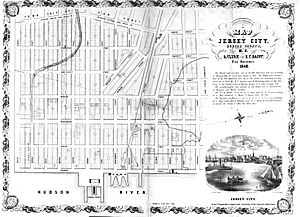Timeline of Jersey City, New Jersey facts for kids
Jersey City, located in New Jersey, has a long and interesting history! It started as a small settlement and grew into a bustling city over hundreds of years. This timeline will take you through some of the most important moments in Jersey City's past, from its early days to the present. You'll learn about how it became a city, how its population grew, and how new buildings and transportation systems changed life for its residents.
Early Days: Before the 1800s
Quick facts for kids History ofNew Jersey |
|
|---|---|
 |
|
| Colonial period | |
| American Revolution | |
| Nineteenth century | |
| Twentieth century | |
| Twenty-first century | |
| Timeline of New Jersey | |
Before the 1800s, the area that is now Jersey City was a small settlement. It was part of a larger region known as Bergen.
The 1800s: A City Begins to Grow
The 1800s were a time of big changes for Jersey City. It officially became a city and started to grow quickly.
- 1802 – The small area called Paulus Hook had only 13 people living there.
- 1804
- Land was bought from Cornelius Van Vorst by a group called the Associates of the Jersey Company.
- The streets of Paulus Hook were planned out.
- 1812 – A new steam ferry started carrying people across the water.
- 1820 – The "City of Jersey" was officially formed within Bergen Township.
- 1824 – The Jersey Glass Company, an early factory, was started.
- 1834
- Important train stations for the New Jersey Railroad and the Paterson and Hudson River Railroad were built.
- A horse-drawn trolley began running between Newark and Jersey City.
- 1836 – The Morris Canal, a waterway for boats, started operating.
- 1838 – The city's name was officially changed to "Jersey City."
- 1840 – Jersey City became part of a new area called Hudson County.
- 1847
- The Dixon Mills and the Colgate & Company soap factory were built. These were big factories for the time.
- 1850 – The city's population grew to 6,856 people.
- 1851 – Van Vorst Township joined Jersey City, making the city bigger.
- 1860 – The population jumped to 29,227 people.
- 1867 – The Evening Journal newspaper began publishing.
Late 1800s: More Growth and New Buildings
The end of the 1800s saw Jersey City continue to expand, adding more areas and important buildings.
- 1870
- Hudson City and Bergen City became part of Jersey City, making it much larger.
- The population reached 82,546 people.
- The Lorillard Tobacco Company moved its business to Jersey City.
- 1873 – Greenville also joined Jersey City.
- 1887 – The Pavonia Terminal, a major transportation hub, opened.
- 1889
- The Free Public Library was created, giving people access to books and learning.
- The Central Railroad of New Jersey Terminal was built.
- 1890 – The population continued to grow, reaching 163,003 people.
The 1900s: Modern Times and Big Changes
The 1900s brought many modern developments to Jersey City, including new transportation and businesses.
- 1900 – The population reached 206,433 people.
- 1905 – West Side Park, a large green space, opened. It's now known as Lincoln Park.
- 1906 – The famous Colgate Clock was put in place.
- 1909 – The Hudson Tubes, an underground train system, started running to Manhattan in New York City. This made it much easier for people to travel between the two cities.
- 1910 – The population grew to 267,779.
- 1912 – Lincoln High School was established.
- 1925 – Journal Square, a busy area, was planned out.
- 1927 – The Holland Tunnel, an underwater road tunnel, opened, connecting Jersey City to Lower Manhattan.
- 1929
- The New Jersey State Normal School at Jersey City opened, which is now New Jersey City University.
- The Loew's Jersey Theatre, a beautiful movie palace, also opened.
- 1930 – The population reached 316,715.
- 1937 – The Jersey City Giants baseball team was formed.
- 1974 – Hudson County Community College was established.
- 1980 – The population was 223,532.
- 1988 – Jersey City formed a "sister city" relationship with Cusco, Peru. This means the two cities agree to be friends and learn from each other.
- 1990 – The population was 228,537.
- 1994 – Sister city relationships were also made with Ahmedabad, India, and Nantong, China.
- 1995 – A sister city relationship was formed with Ozamiz, Philippines.
- 1997
- Bret Schundler became mayor of Jersey City.
- The E-ZPass system for paying tolls was activated for the Holland Tunnel.
- Sister city relationships were established with Jerusalem, Israel, and Vitória, Brazil.
- 1998 – Parts of Ellis Island were officially decided to be part of Jersey City.
- 1999 – The Jersey City Landmarks Conservancy was created to protect historical buildings.
The 2000s: Into a New Century
The 21st century has seen Jersey City continue to evolve, with new cultural institutions and leadership.
- 2001
- The Jersey City Museum opened, showcasing art and history.
- A sister city relationship was established with Kolkata, India.
- 2004 – Jerramiah T. Healy was elected mayor.
- 2008 – A sister city relationship was established with Rosario, Argentina.
- 2010 – The population was 247,597.
- 2011 – The Golden Door Film Festival began, celebrating movies.
- 2013 – Steven Fulop became mayor.
- 2023 – The Museum of Jersey City History opened at The Apple Tree House.


